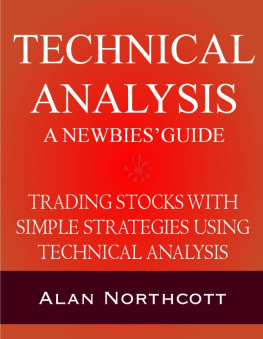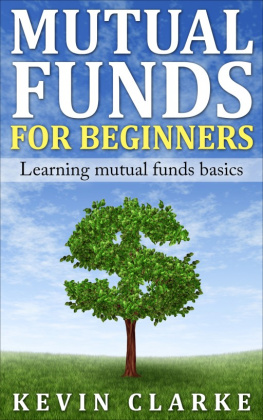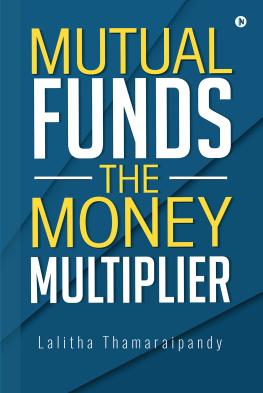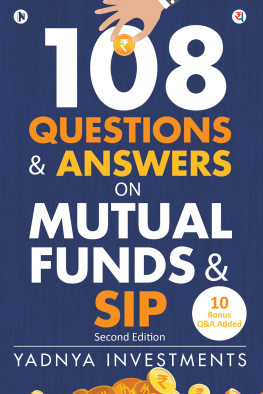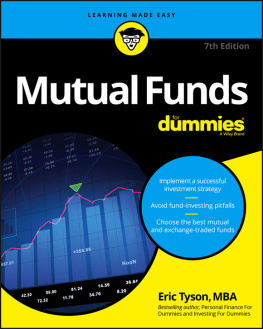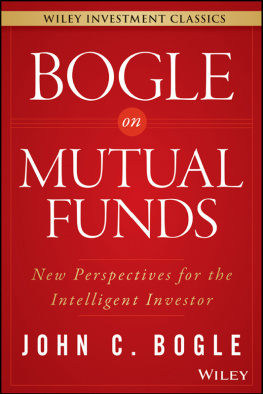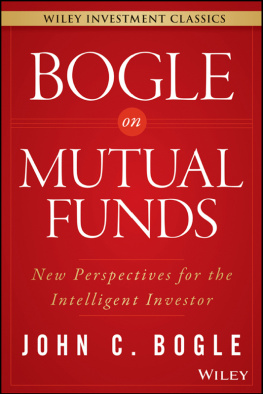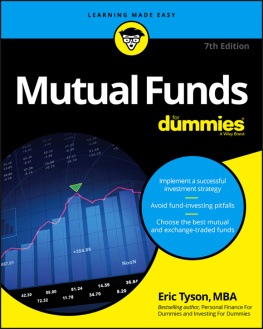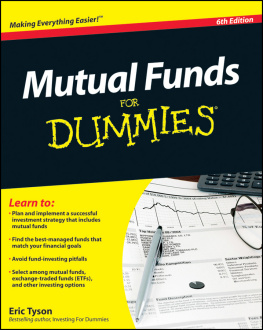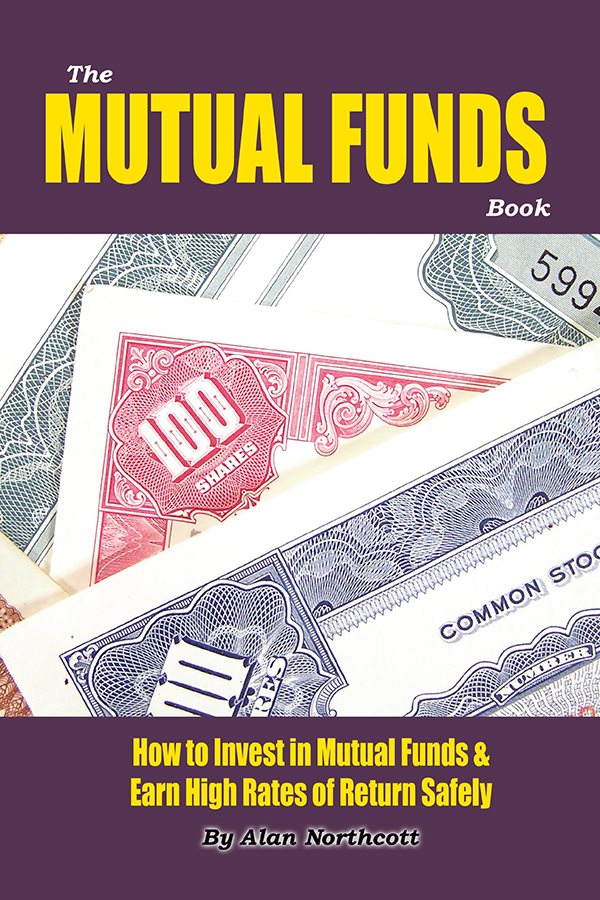The Mutual Funds Book:
How to Invest in Mutual Funds & Earn High Rates of Returns Safely
By Alan Northcott
The Mutual Funds Book: How to Invest in Mutual Funds & Earn High Rates of Returns Safely
Copyright 2009 Atlantic Publishing Group, Inc.
1405 SW 6th Avenue Ocala, Florida 34471 Phone 800-814-1132 Fax 352-622-1875
Web site: www.atlantic-pub.com E-mail:
SAN Number: 268-1250
This publication is protected under the US Copyright Act of 1976 and all other applicable international, federal, state and local laws, and all rights are reserved, including resale rights: you are not allowed to give or sell this ebook to anyone else. If you received this publication from anyone other than an authorized seller you have received a pirated copy. Please contact us via e-mail at and notify us of the situation.
No part of this publication may be reproduced, stored in a retrieval system, or transmitted in any form or by any means, electronic, mechanical, photocopying, recording, scanning, or otherwise, except as permitted under Section 107 or 108 of the 1976 United States Copyright Act, without the prior written permission of the Publisher. Requests to the Publisher for permission should be sent to Atlantic Publishing Group, Inc., 1405 SW 6th Avenue, Ocala, Florida 34471.
Northcott, Alan, 1951
The mutual funds book : how to invest in mutual funds & earn high rates of returns / by Alan Northcott.
p. cm.
Includes bibliographical references and index.
ISBN-13: 978-1-60138-001-2 (alk. paper)
ISBN-10: 1-60138-001-1 (alk. paper)
1. Mutual funds. 2. Portfolio management. 3. Investments. I. Title.
HG4530.N665 2009
332.6327--dc22
2009027205
LIMIT OF LIABILITY/DISCLAIMER OF WARRANTY : The publisher and the author make no representations or warranties with respect to the accuracy or completeness of the contents of this work and specifically disclaim all warranties, including without limitation warranties of fitness for a particular purpose. No warranty may be created or extended by sales or promotional materials. The advice and strategies contained herein may not be suitable for every situation. This work is sold with the understanding that the publisher is not engaged in rendering legal, accounting, or other professional services. If professional assistance is required, the services of a competent professional should be sought. Neither the publisher nor the author shall be liable for damages arising herefrom. The fact that an organization or Web site is referred to in this work as a citation and/or a potential source of further information does not mean that the author or the publisher endorses the information the organization or Web site may provide or recommendations it may make. Further, readers should be aware that Internet Web sites listed in this work may have changed or disappeared between when this work was written and when it is read.

Table of Contents

Dedication

Dedicated to my beautiful wife, Liz, my constant companion through lifes adventures and my strength for more than 30 years.
Chapter 1

Introduction to Mutual Funds
If you are like many people, you might believe you already know what mutual funds are, and you are reading this book to help you decide which to invest in. But if you have not researched mutual funds before, you may be surprised by the range and number available, and it will be worth your while to discover the variety you can invest your money in.
Simply put, mutual funds are a means to invest in something along with other people. The advantage this offers over investing your money individually is having a professional fund manager whose job is to look after the invested funds and make any necessary adjustments according to his or her knowledge and experience. The mutual fund, as a whole, amounts to more money than you could invest alone, which may open up possibilities for investment by a manager who can produce greater returns. The large size of the portfolio means that the manager can diversify the holdings more than you could on your own, which spreads the risk.
There are a wide range of potential purchases for the manager. It is not as simple as just buying some stocks or bonds; there are many variations available for the mutual fund manager to choose from, and you will select the fund and management according to both the level of risk you find acceptable and your ideal return. You can invest in money market funds, income funds, growth funds, value funds, index funds, sector funds, international funds, and other permutations. Successful investing takes time, and you will find that, overall, the price you pay for professional management is relatively cheap compared with the value that you will receive.
The History of Mutual Funds
For as long as people have had markets to invest in, groups of people have banded together to combine their money and expertise to make better returns. The mutual fund is a logical extension of this idea, in which the investors pay someone to manage their money and commit the time to research investments, resulting in more informed investing.
In the 19th century in the United Kingdom, organizations called investment trusts sold shares to investors. This was the likely origin of a company looking after investors money, and the idea was adopted in the United States in 1924. Many of the first funds were closed-end funds, meaning there were a certain number of shares for sale that were subsequently traded by the owners who made the market.
The Early Years
The first open-end mutual fund was created by Edward Leffler, who previously sold securities. By 1929, there were 19 open-end funds holding a total of $140 million, which seems like considerable money for the time. However, at the same time, there were nearly 90 closed-end trusts, which held $3 billion in total assets.
The timing of the birth of these funds was not favorable, and the problems encountered by the funds in the Stock Market Crash of 1929 were compounded by managers leveraging the assets of the investors a common practice when an investor feels that the market will only go upward and borrows money to multiply his or her gains. Notice that the lessons of the past are not always learned, as evidenced by financial companies such as Lehman Brothers in the present day still being caught out by over-leveraging the funds at their disposal.
The open-end funds fared better in the Stock Market Crash than the closed-end funds did. Managers of the closed-end funds were secretive and did not always disclose what shares were held. The managers could even value the shares at whatever price they chose, which led to dubious practices. In contrast, the open-end funds had a policy of declaring a net-asset value, as they permitted redemption upon demand, and this served to keep out the extremes of borrowing and other manipulations.
The Introduction of Regulation
As a consequence of the great Crash, Congress passed a succession of laws involving securities. In 1933, the Securities Act set rules for anyone who offered publicly traded securities, requiring that the company offering the securities register them with the Federal Trade Commission and produce a prospectus to describe the securities to potential investors.


